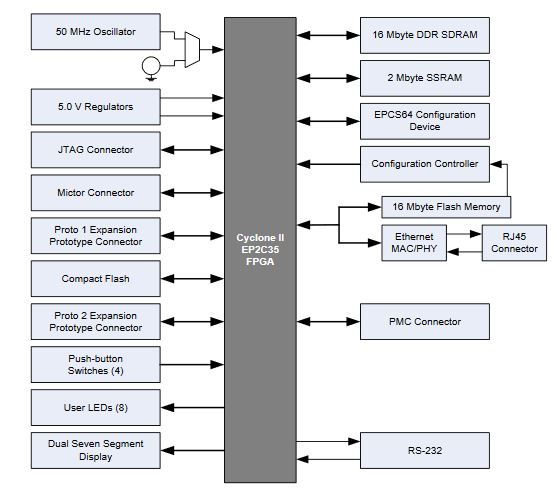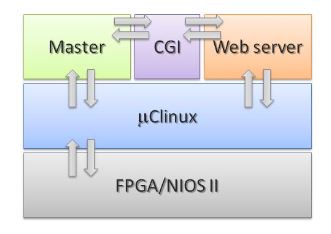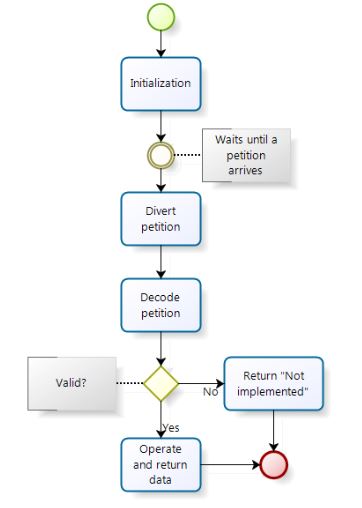ABSTRACT
This article describes the implementation of a web server using an embedded Altera NIOS II IP core, a general purpose and configurable RISC processor which is embedded in a Cyclone FPGA. The processor uses the μCLinux operating system to support a Boa web server of dynamic pages using Common Gateway Interface (CGI).
The FPGA is configured to act like the master node of a network, and also to control and monitor a network of smart sensors or instruments. In order to develop a totally functional system, the FPGA also includes an implementation of the time-triggered protocol (TTP/A). Thus, the implemented master node has two interfaces, the webserver that acts as an Internet interface and the other to control the network.
This protocol is widely used to connecting smart sensors and actuators and microsystems in embedded real-time systems in different application domains, e.g., industrial, automotive, domotic, etc., although this protocol can be easily replaced by any other because of the inherent characteristics of the FPGA-based technology.
SYSTEM DESCRIPTION

Figure 2 . Development board scheme
To implement the embedded web server, we have used the Altera Cyclone II EP2C35. This FPGA contains 33,216 logic elements, 105 memory blocks of 4 Kbits, 35 multipliers, 4 PLLs, 475-pin input/output and can operate at a maximum frequency of 260 MHz. It is located in the Nios II Embedded Development Kit. The development board scheme is depicted in Figure 2.

Figure 5. Architecture of the implemented system
The architecture of the implemented system is represented in Figure 5. We have used a NIOS II FPGA as hardware technology. The operating system handles communication with hardware and deployed applications, i.e., TTP/A master node controller and web server. The TTP/A master node controller and a web interface runs on a dynamic page web server using Common Gateway Interface (CGI).
IMPLEMENTING THE SENSORS NETWORK MASTER NODE

Figure 8. Architecture of the master node
The implementation was made using the C programming language, taking advantage of its power and the facilities it provides, such as system calls, sockets and threads. Thus, the master may be seen as a running program that executes the part of the protocol TTP/A that corresponds to high priority. It also can be seen as a server that responds to external world requests for configuration and management (Figure 8). These requests are served through a low-priority thread and the use of sockets for remote access.

Figure 10. Server threads flow of execution
The server operation scheme is shown in Figure 10. It is easily seen that the server behavior is similar to a common server. At the beginning of its execution, the server is initialized preparing itself to receive connections. Then, it keeps listening for a request through a socket created in the port that has been assigned to it.
RESULTS AND DISCUSSION
The whole system was implemented in a Cyclone II EP2C35 FPGA that is in the NIOS II development board Embedded Development Kit. This FPGA is configured on a standard NIOS II processor with μClinux as the operating system. On this system we ha ve implemented an embedded web server and the master node with tasks related to TTP/A protocol and services with the outer world. The prototype employs 2065 LES of the FPGA hardware resources (about 7%), including the core processor and all peripherals used in the design.
CONCLUSIONS AND FUTURE WORK
We have implemented a web interface that can be used as an affordable and versatile control system, applicable to the control of a large number of sensor nodes or instruments, either remotely or within a private network or via Internet. The design has been done using a Cyclone II FPGA to support hardware, configured with NIOS II embedded microprocessor which supported the implementation of an embedded web server.
The use of these technologies has yielded a flexible prototype with a relatively short development time. The implementation of the system control application has been made in C language reducing its complexity. In addition, other master controls can be added to control more devices if they have the necessary communication routes to control the new slaves.
The chosen interface effectively accomplishes its objectives while its use is easy contributing to an acceptance of the system by its users. By defining the TTP/A protocol as well as the architecture of the implemented system, which allows independence of the user interface, the design is open to future improvements of the protocol as well as other related to the interface above, applying new technologies that maybe developed in the future.
Source: University of La Laguna
Authors: Eduardo Magdaleno | Manuel Rodriguez | Fernando Perez | David Hernandez | Enrique Garcia